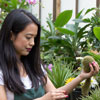There’s something almost magical about walking through my fig orchard on a warm San Diego morning, checking the ripening fruit as the coastal breeze carries that distinctive sweet aroma only Ficus carica can produce. You know, when people ask me which exotic fruit gives me the most satisfaction to grow, they’re often surprised when I say figs. “Aren’t those common?” they’ll ask. But here’s the thing – once you dive into the incredible diversity of fig varieties, you realize these ancient fruits are anything but ordinary.
Let me take you on a journey through the fascinating world of fig types, drawing from my own experiences cultivating these Mediterranean gems in Southern California’s unique microclimate. Whether you call them common figs, edible figs, or simply higos (as my Spanish-speaking neighbors do), these fruits represent one of humanity’s oldest cultivated crops – and trust me, there’s a reason they’ve stuck around for over 11,000 years.
Understanding the Main Categories: It’s Not Just About Color
When I first started growing figs commercially, I made the rookie mistake of thinking variety selection was simply about choosing between light and dark fruits. Boy, was I wrong! The classification system for Ficus carica is actually based on how the fruit develops and whether it requires pollination – though honestly, in practical terms, most of us growers focus on what’s called the Common Fig group.
Here in San Diego, we’re blessed with a climate that perfectly suits what I call the “no-wasp-needed” varieties. These are the common figs that develop through a process called parthenocarpy – basically, they set fruit without pollination. This is crucial because the specialized fig wasp (Blastophaga psenes) needed for pollinating Smyrna-type figs isn’t reliably present in our area. I learned this the hard way when I tried growing Calimyrna figs my first season. Beautiful trees, zero harvestable fruit!
The Four Main Fig Types:
- Common Figs – Develop fruit without pollination; perfect for home gardens and commercial operations in California
- Smyrna Figs – Require pollination by fig wasps; think Calimyrna variety
- San Pedro Figs – Produce two crops: an early one without pollination and a later one requiring it
- Caprifigs – Inedible figs that house the wasps needed for pollinating other types
The Stars of My Orchard: Varieties That Actually Perform
Black Mission: The Workhorse That Never Disappoints
If there’s one variety I’d recommend to anyone starting out – whether you’re in the professional farming game or just want a backyard tree – it’s Black Mission (sometimes called Franciscana or simply Mission fig). This Spanish heirloom has been grown in California since the 1700s, brought here by missionaries establishing the mission system. The name tells you everything about its history.

I’ve measured sugar content (Brix levels) in my Mission figs reaching 22-24% at peak ripeness – that’s sweeter than most table grapes! Last season, my 50 Black Mission trees produced roughly 1,200 pounds of fresh fruit, with about 60% going to farmers’ markets and the rest to a local artisan jam producer. The reliability of this variety is unmatched.
Brown Turkey: The Crowd-Pleaser
Now, if you want versatility, Brown Turkey (also known as Aubique Noire in France or Negro Largo in Spain) is your friend. This variety has become incredibly popular in American landscapes, and for good reason. The fruit has a bronzy-purple exterior with pink-amber flesh that’s milder and less intensely sweet than Mission – some customers actually prefer this more subtle profile.
What I love about Brown Turkey is its cold hardiness. While San Diego rarely sees frost, I have several trees at a slightly higher elevation property, and these babies have survived temperatures down to 15°F without significant damage. The trees themselves are also more compact than Mission, making them easier to manage and harvest. My Brown Turkey section produces fruit that’s slightly larger than Mission – averaging about 2.5 ounces per fig compared to Mission’s 1.8 ounces.
Kadota: The Commercial Powerhouse
Here’s a variety that doesn’t get enough love in home gardens but is absolute gold for commercial operations: Kadota (sometimes labeled as Dottato in Italy). These are classified as white figs, though they’re really more of a yellow-green color with amber flesh. Originally from Italy, Kadota figs became a California staple because they’re perfect for canning and drying.
I grow about 30 Kadota trees specifically for a dried fig contract I have with a specialty food company. The sugar content in these fruits can hit 25% or higher, and they dry beautifully without fermenting. One thing that makes Kadota special for growers is its resistance to fruit souring – a bacterial infection that can devastate other varieties in humid conditions. Even during our occasional muggy summer days when marine layer hangs around, my Kadotas keep producing clean fruit.
Desert King and Other Surprises
Want to know a secret? Some of my most profitable trees are the ones that produce primarily breba crops. Desert King is a perfect example. This variety, despite its name suggesting arid conditions, actually originated in the Pacific Northwest and thrives in our coastal climate. The breba crop comes in large – we’re talking 3-4 ounce figs – and ripens in June when fig selection at markets is limited.
The main crop on Desert King is often sparse or nonexistent here, but that single early crop commands premium prices. I’m talking $8-10 per pound at farmers’ markets because there’s simply nothing else like it available that early. Last June, my 15 Desert King trees generated nearly $4,000 in revenue from that single breba harvest.
The Climate Connection: Why San Diego Is Fig Paradise
| Variety | Heat Requirement (Hours >86°F) | Chill Hours Needed | Drought Tolerance | San Diego Performance |
|---|---|---|---|---|
| Black Mission | Low-Medium | 100-200 | Excellent | Outstanding |
| Brown Turkey | Low | 100-200 | Excellent | Outstanding |
| Kadota | Medium | 100-200 | Very Good | Excellent |
| Desert King | Low | 300-400 | Good | Excellent (Breba) |
| Chicago Hardy | Very Low | 500-600 | Good | Moderate |
| Panache | Medium | 200-300 | Very Good | Excellent |
You might wonder why I’ve included chill hours and heat requirements in this table. Here’s the deal: San Diego’s Mediterranean climate is nearly perfect for figs, but it’s not identical across the county. My coastal properties get maybe 100-150 chill hours (hours below 45°F in winter), while friends growing figs in Ramona or Julian might see 400-500. This affects variety selection significantly.
The beauty of our climate is the long, warm growing season without extreme heat. Figs don’t love temperatures over 100°F – the fruit can actually sunburn and stop ripening properly. Our typical summer days in the 75-85°F range with cool nights? That’s fig heaven. The fruit develops complex flavors slowly, and I rarely see heat damage even in September.
Beyond the Basics: Specialty Varieties Worth Exploring
Once you’ve mastered the common varieties, the world of specialty figs opens up like, well, like a perfectly ripe fig! I’ve been experimenting with some truly unique cultivars that fetch premium prices from chefs and specialty food enthusiasts.
Panache (also called Tiger Fig or Striped Fig) is a showstopper – literally. The exterior has green and yellow stripes, while the interior boasts strawberry-red flesh. When I bring these to farmers’ markets, they sell out first every time. The flavor is excellent, though honestly, I think 30% of the appeal is pure aesthetics. Chefs love using them for plating because they’re so visually striking.
Violette de Bordeaux is my personal favorite for fresh eating. These are small, deep purple figs with a complex berry-like flavor that’s hard to describe. Think of it as the wine connoisseur’s fig – there’s a depth and sophistication to the taste that simpler varieties lack. The trees are slower to establish and produce smaller yields, which is why I only have five of them, but every fruit is precious.
Then there’s Excel, a Yellow fig variety that performs exceptionally well in our heat. Excel figs are large, have a honey-like sweetness, and the trees are vigorous growers. I actually use Excel as a “gateway fig” for customers new to the fresh fig experience because they’re sweet without being overwhelming.
The Science of Fig Sweetness: What Makes One Variety Better Than Another?
Have you ever wondered why some figs taste like candy while others are merely pleasant? It comes down to several factors, and understanding them has helped me maximize quality in my orchard.
First, there’s the obvious: sugar content. But it’s not just about raw sweetness. The ratio of glucose to fructose matters, as does the presence of other compounds. Black Mission figs, for instance, contain higher levels of anthocyanins (the compounds that make them dark) which contribute subtle flavor notes beyond sweetness.
Second, acid balance is crucial. A fig with 24% sugar but no acid tastes flat and one-dimensional. Varieties like Brown Turkey have a better acid-to-sugar ratio, giving them complexity. I actually measure pH in my figs (it usually runs between 4.5-5.5) to gauge harvest timing.
Third, and this is something many growers overlook, volatile aromatic compounds make a huge difference. Research from UC Davis has identified over 100 volatile compounds in figs, including benzaldehyde (almond-like), furaneol (strawberry notes), and various terpenes. The specific mix varies by variety and growing conditions.
My Step-by-Step Process for Selecting New Varieties to Trial:
- Research cold and heat tolerance – Does the variety match my specific microclimate?
- Evaluate market demand – Will customers actually buy this, or is it just interesting to me?
- Check disease resistance – Some varieties are magnets for rust or mosaic virus
- Assess productivity – I need at least 15 pounds per tree annually to justify the space
- Trial on small scale – Start with 2-3 trees before committing to more
- Collect customer feedback – The market tells me what works
- Monitor for three full seasons – One good year doesn’t make a reliable variety
Practical Growing Insights: What Actually Matters
Let me share something that took me years to figure out: variety selection matters far less than growing conditions. I know that sounds contradictory in an article about varieties, but hear me out. I’ve seen backyard growers produce better Black Mission figs than commercial operations simply because they managed water, fertilization, and pruning better.
That said, matching variety to purpose is essential. If you’re growing for fresh market sales like I do, you want varieties that:
- Ripen during your market days (mine are Saturdays)
- Hold well for 2-3 days after harvest
- Have eye appeal and unique characteristics
- Don’t split easily in our occasional summer rains
For drying operations, you need different characteristics: high sugar content, small seed cavity, and resistance to souring. This is why Kadota dominates the dried fig industry.
Here’s a comparison table showing how different varieties stack up for various uses:
| Variety | Fresh Eating | Drying | Preserves/Jam | Ornamental Value | Ease of Growing |
|---|---|---|---|---|---|
| Black Mission | Excellent | Excellent | Excellent | Good | Very Easy |
| Brown Turkey | Excellent | Good | Very Good | Good | Very Easy |
| Kadota | Very Good | Excellent | Very Good | Fair | Easy |
| Desert King | Excellent | Fair | Good | Good | Moderate |
| Panache | Excellent | Fair | Good | Excellent | Moderate |
| Violette de Bordeaux | Excellent | Good | Excellent | Good | Moderate |
The Economics of Variety Selection
Let’s talk money, because at the end of the day, this is a business for me. I track revenue per tree for each variety, and the results might surprise you. Black Mission, despite being the most common, generates about $180 per tree annually in my operation. But Desert King, with its single early crop, brings in nearly $270 per tree!
Why? Timing and scarcity. Those June figs face zero competition. By August, every backyard gardener with a Brown Turkey tree is giving away fruit to neighbors. Supply and demand works the same way in agriculture as anywhere else.
Specialty varieties like Panache command $12-15 per pound retail, compared to $6-8 for standard varieties. However, Panache trees in my orchard produce maybe 60% of what a Black Mission produces. So we’re looking at roughly 12 pounds per tree at $13.50 average = $162 per tree. Still profitable, but less than the workhorses.
The real winners in my operation are multi-purpose varieties. Black Mission figs I can’t sell fresh get dried, and those I can’t dry get made into preserves through a partnership with a local producer. This flexibility means nearly 100% of the crop generates revenue somehow.
Looking Forward: The Future of Fig Farming
Climate change is real, folks, and it’s affecting what I grow and how I grow it. Over the past few seasons, I’ve noticed our traditional fog patterns changing. Some coastal areas are getting less marine layer influence, which means higher temperatures earlier in the season. This has actually benefited some of my heat-loving varieties like Excel but challenged others.
I’m also seeing increased interest in figs as a sustainable crop. They require far less water than citrus or avocados – critical here in perpetually drought-prone California. A mature fig tree in my orchard uses about 35-40 gallons per week during peak season, compared to 75-100 gallons for an equivalent-sized avocado tree. That water efficiency is becoming a major selling point.
New varieties keep emerging from breeding programs. I’m currently trialing a few selections from UC Davis that show promise for even better disease resistance and productivity. The scientific name remains Ficus carica, but the diversity within that species keeps expanding.
Wrapping It All Up
So, what’s the best fig variety? That’s like asking what’s the best tool in a toolbox – it depends entirely on what you’re trying to accomplish. For reliable production in San Diego with minimal fuss, you can’t beat Black Mission. For early season profits, Desert King is golden. For wow-factor and premium pricing, Panache or Violette de Bordeaux deliver.

Every variety tells a story, carries generations of selection and cultivation in its genes, and offers something unique to the table. As you explore the world of figs, whether as a grower, a buyer, or simply a curious food lover, I encourage you to taste as many varieties as possible. Your palate will discover favorites you never knew existed, and you’ll understand why this fruit has captivated humanity for millennia.
Now, if you’ll excuse me, I’ve got a batch of Kadota figs that need checking – there’s nothing quite like that moment when you touch a fig and feel it’s reached perfect ripeness. Some things, no matter how much farming changes, remain eternally satisfying.








